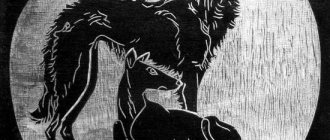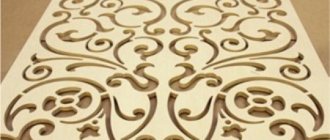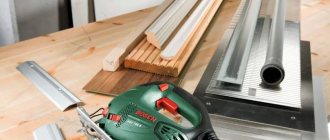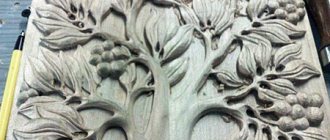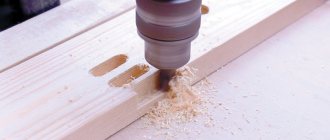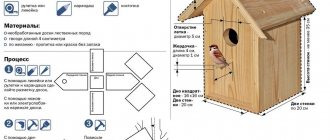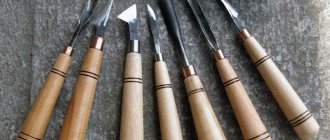A couple of days ago I moved to a newly built dacha. I’ve already unpacked, set up the furniture, and as I walk around I feel like there’s not enough atmosphere. I decided to make several fakes using a hand jigsaw from plywood that was left over after construction. Therefore, next I’ll tell you a little about the cutting process itself and show you the drawings and stencils for cutting with a hand jigsaw that I used.
Source nestling.com.ua
Cutting plywood products with a hand jigsaw requires time, attention and patience. However, it is worth it - the result can be beautiful and, most importantly, practical products.
What can be made from plywood
A hand saw is used to create decorative elements of plywood products. And as a result of this processing of wood, plywood or plastic, a variety of crafts are created that have aesthetic significance and practical application.
The process of figure sawing itself is a fascinating hobby, which brings both material and moral benefits to those who practice it.
Drawings, drawings, pictures and ideas of what can be made from plywood using a jigsaw:
Source pinimg.com
Source pinimg.com
Source pinimg.com
Source opilah.com
Source pussikbouquet.rf
Source miracle-lobzik.ru
As you can see, from ordinary plywood or a wooden blank you can independently make a large number of products, which include a vase for sweets, a lamp, a basket, a photo frame, a stand for cards, a hanger in the corridor, a pincushion, a panel, a bread bin, a stand for eggs or hot dishes, a box, a candlestick and much more.
If you are just starting to carve, then first take simple drawings, diagrams, drawings or sketches for carving. Choose ideas for making wooden products using a hand jigsaw that will please you with their appearance.
Once you have mastered the cutting techniques, you can raise the bar and start cutting out jewelry models with openwork fragments.
You can also make platbands for home design using a jigsaw.
Using stencils for cutting, you can make homemade products much easier and faster from wooden blanks or plywood.
At the same time, handmade products will emphasize the style and complement the design of the room.
Sawing with a jigsaw: tools
The first thing you need to cut out plywood figures with your own hands is a jigsaw.
Such a tool is represented quite extensively on the domestic market and in several main types:
- Manual. A tool familiar to many from labor lessons at school. As the name suggests, all cutting work will need to be done manually. The best choice for creating small things or teaching children the skills of this exciting process;
- Electric. It works much faster than a manual one, but at the same time, it has a significant mass (1-3 kg), and therefore it is quite inconvenient to hold it “in weight”. Yes, and it will not be possible to create a thin pattern, since the blade of the file is too large for such jewelry work;
Drawing for woodworking
Stationary. The only drawback of such a tool is its price - it is much higher than that of an electric or manual device. Nevertheless, the device is very convenient for the carver; it does not need to be held suspended, and although the cutting line will be rougher than that of a manual “colleague,” the speed of work is still many times higher.
The choice of one or another tool for creating various structures from wood raw materials depends only on the amount of work and the personal preferences of the master himself. If, for example, working with a jigsaw on plywood is just a hobby, then a hand tool will be quite enough.
Preparation of raw materials and stencil
For those people who have skillful hands and extensive experience working with tools, cutting out plywood with a jigsaw will not be difficult. First, you will need to take a piece of material on which the design will be applied and sand it to a smooth surface with fine sandpaper.
After such preparation, it will be enough to apply the desired drawing and begin the process itself.
Traditional template for wood raw material sheet products
Well, novice craftsmen, in order not to spoil the material and get really interesting and beautiful elements, will first need to download special drawings on the Internet for cutting out of plywood with a jigsaw. Currently, the choice of such decorative pictures is really large; you can download certain options for every taste for free without any problems. (see also the article Cutting out plywood with a jigsaw - drawings for success)
All you need to do after downloading the drawing is to print it, transfer it to a sheet (you first need to prepare it with sandpaper) and start working with the tool along the contour.
Thus, even the person who has started working with a jigsaw for the first time will be able to get a beautiful product with an even contour that will become a real decoration for the home. (see also the article Laser cutting of plywood: technology features)
The process of sawing wood: features
The process of creating decorative parts from wood is even simpler than applying a design to a sheet of material. It is enough to simply insert the file into the pre-made hole (for this you can use a hand brace or an electric drill) and start working along the drawn contour.
Photo of a beautiful box made from a sheet of pressed wood
Moreover, if the work is performed with hand tools, then all movements must be smooth, without jerking, otherwise you can simply break the fragile jigsaw file.
If everything is done correctly, then in the end you can get a uniquely beautiful design, transferred exactly to the material, a detail that can advantageously decorate any room or facade of a building.
Additional finishing
To make a product created from a sheet of material using a jigsaw look even more beautiful and original, it can be further trimmed. First, you should sand all surfaces with sandpaper, eliminating all small irregularities and roughness.
Afterwards, you can varnish or stain the entire surface of the plywood product, cover it with paint or other finishing materials. Prefabricated decorative product made from a single sheet
It should be noted that cutting out plywood with a jigsaw allows you to obtain not only solid, but also prefabricated structures. In the latter case, the final finishing will also be accompanied by joining several elements together using special glue or shingled nails.
The main thing in the process of creating a prefabricated product from several parts, even during the work process, is to pay special attention to the cutting line; it should be positioned so that the notch is somewhat smaller than always. Stationary jigsaw for making products
Stationary jigsaw for making products
Procedure
In order to obtain high-quality products and minimize the number of defects during work, you need to do everything slowly and thoughtfully, and you should also focus on the process itself.
Before you start cutting, you should make sure that the thickness of the plywood or wood workpiece is equal to the height of the groove, which is located on the printed sketch.
Source 2proraba.com
How to carve plywood
Working with the device will not be difficult if you properly prepare for the creative process.
- The work area must have good lighting;
- The working plane must be protected from damage. You can, for example, lay a sheet of plywood or cover it with film;
- All necessary tools and spare blades should be prepared in advance. And we can begin.
The first step should begin with drawing the inner outline of the drawing or drawing. To do this, you need to make slots into which the blades of the device will be inserted. Usually, when cutting large contours, there is no problem, but in small remnants, working with a jigsaw from the inside can cause chips, burrs or cuts. You must act very carefully.
Working with a jigsaw
- Secure the working material on the table so that the blade does not catch on the surface of the plywood.
- Turn on the device and start cutting.
The jigsaw is not very difficult to control: move the tool forward along the lines. If the equipment is equipped with additional options for tracking the result of work, use them. Working with a jigsaw - After finishing cutting, sand the ends with sandpaper or files.
- Carry out further finishing work on the cut product: varnishing, painting, etc.
How to saw with a hand jigsaw
- Secure the piece of plywood with one hand and hold the cutting jig by the handle with the other.
- Start moving along the drawn contours, moving the jigsaw up/down. This should be done around the perimeter of the drawing.
Working with a manual jigsaw
As you can see, there is nothing super complicated in this work. And you will acquire a real creative hobby by learning how to operate these devices.
How to cut plywood with a jigsaw
Sawing plywood with an electric or manual jigsaw is undoubtedly a creative process. And you will be able to create decorative items of various styles with your own hands: from fairy-tale cartoon characters for children to decorations for furniture and home.
Preparing the stencil
Keep in mind that drawings, diagrams and sketches for cutting come in different sizes.
For example, to make an interior item, say a shelf, you need to use whatman paper in A1 or A0 format, and to create some toys you can even use an ordinary sheet of cardboard.
Well, then the outline of the product is applied to the surface of the workpiece; during this process it is necessary to maintain the exact dimensions of the drawing.
You can find templates for cutting with a hand jigsaw on special resources, but it is easier to come up with your own ideas using a simple model as a basis and taking into account the type of workpiece.
An individual approach when developing a drawing, template or diagram of a future product is welcome, because it will emphasize the very texture of the wood.
Source pinimg.com
Artistic cutting with a jigsaw: drawing, stencil and work
Let's get to know the devices
A jigsaw is a toolkit that is designed for working on different contours. The device includes a blade equipped with teeth small enough to cut the working material, practically without forming burrs or chips.
Manual
The “founder” of the genus is, of course, the manual jigsaw. Everything ingenious is simple: a metal U-shaped arc, and a working blade is stretched between the ends, which is secured with clamps. They hold the files during operation, and with their help, its tension is also adjusted. The handle for convenient operation is located on one side of the frame. The tool clamps can be rotated, thereby creating a different plane for carrying out work, providing opportunities for carving plywood with a jigsaw of increased complexity.
Adviсe:
- When creating with a hand-held device, you must be extremely careful: the design is quite fragile, and with intense pressure, the blade sometimes breaks and needs to be replaced. Every novice craftsman should stock up on additional working files.
- When working with a jigsaw, it is convenient to use an auxiliary board: it protects the table and solves problems with the convenient location of the plywood workpiece.
Jigsaws
This device operates using electricity. It is a housing where the mechanism is located, and the control handle is also located there. The sawing element is located at the bottom of the device at the front. The blade is protected, and this allows you to cut along the contour very smoothly, without deviations. Professional models of equipment have many attachments that greatly facilitate the work process, for example, leveling the edge of the material. Jigsaw blades can also have teeth that vary in shape and size. They should be selected in accordance with the material for the saw to avoid damage to the plywood sheets during operation.
- Household electric jigsaws for non-production purposes are usually of low power (from 350 to 500 W). For beginners, this is the most common option when you are just learning to cut out crafts and figures from plywood (usually of small thickness). It is quite safe to operate such a device, especially when it is equipped with protection.
- A professional jigsaw is intended for industrial purposes, has a power of more than 700 W, high speed and cutting accuracy. It can cut sheets over 10 cm thick, aluminum, and thin steel.
Video: simple jigsaw:
Fraser
Sometimes this device is used for carving. It is a type of special hand tool, with the assistance of which you can perform various types of work on wood and plywood in everyday conditions. However, working with it requires some skill; but craftsmen who deftly handle this equipment can create real, highly artistic masterpieces of folk art.
Preparing the stencil
Drawings for creative work come in different sizes, depending on the scale of the products being manufactured. For example, for diagrams of a shelf or a piece of furniture, for a three-dimensional toy, you should take a sheet of whatman paper in A1 format, a roll of wallpaper left after repair may also be suitable, and for small figures (such as souvenirs) we take office paper (A4 or A3 format).
Using a marker or pencil, we draw the contours of the future object on the surface of the paper, adhering to the specified dimensions. Templates are presented in the public domain in a wide range, we choose the appropriate one (for beginners, as a rule, it is not too complicated). Or you can come up with your own options for cutting with a jigsaw and then transfer it to a paper base.
Then we transfer the images to the surface of the working material (plywood, boards). To do this, cut out a figure from paper, apply it to plywood and carefully trace along the contour with a pencil. The lines must be precise and even. If necessary, correct it by erasing it with an eraser.
The contours are applied “from the rear” of the material so that no remnants of the drawing are noticeable on the finished form. The internal areas can also be shaded so as not to cut off an extra piece, thereby indicating an inviolable fragment.
Vase
Snowflake
Deer
Typewriter
How to transfer images to the surface of a workpiece
In order to apply a contour to the surface of your plywood or wood workpiece, print the template itself on fairly thick paper.
If you draw the pattern ornament with a pencil, then various hassles may arise when transferring the drawing from your A4 diagram.
Therefore, to apply complex patterns and the contours themselves, auxiliary methods should be used.
One of these methods uses carbon paper.
The first step when using this method is to place a carbon copy on the workpiece.
Afterwards the template itself is placed on top, and then the lines are simply drawn. The template can be glued to the workpiece using 2-sided tape.
But you can also use regular glue. However, you should thoroughly clean the entire surface with sandpaper.
The next method of applying a contour to a workpiece is more accessible. After all, it uses a stencil that is made using ordinary nail scissors.
First, preparation takes place, and then the template is applied to the surface of a plywood or wooden blank and simply outlined with a pencil.
For greater convenience and high-quality application, the sheet is secured with adhesive tape or tape. Also, if desired, the design can be applied using a thermal method instead of a pencil. An inkjet printer is used for this. It is used to print out the diagram.
After that, the printed drawing is applied with its front side to the surface of the material from which the craft is cut out, and processed with a preheated iron.
Source ytimg.com
What is a jigsaw: general description
A jigsaw is a tool designed for cutting various contours from plywood, including curved ones. It is equipped with a blade with fine teeth that can make an even cut of plywood without the formation of significant burrs.
Hand tool
The ancestor of this type of tool is a manual jigsaw. It consists of a metal arc in the shape of the letter “U”, between the ends of which a sawing blade is stretched and attached to clamps. They securely hold the file during operation and allow you to adjust its tension. On one side of the frame there is a handle.
The clamps on the tool can rotate, creating different planes for sawing, thereby providing the opportunity for wood carving of varying complexity.
When cutting from plywood with a hand jigsaw, you need to be careful: its design is quite fragile, and during intensive work, the blade often breaks from force and heat, so it has to be replaced. To do this, each master must have several dozen spare files.
When working with a jigsaw to carve internal contours, it is convenient to use such an auxiliary board as in the photo: it will help both protect the table and solve the problem of convenient placement of the workpiece.
Jigsaw
The tool operates from an electrical network. It is a housing in which the working mechanisms are located, and there is also a handle for control on it. The sawing organ is located in the lower front part. The blade is often protected by a foot, which allows you to cut the contour exactly along the line without deviation. Advanced and professional jigsaw models have various attachments that facilitate the cutting process and straighten the edges of plywood.
Blades can have different teeth in shape and size. It is necessary to select saw blades that are appropriate for the material being processed so that damage and damage to the plywood sheet does not occur during operation of the mechanism.
Classification of jigsaws by power and application:
- Jigsaws for household use are usually equipped with a low power of 350-500 W. A household jigsaw for beginners is the best option if you want to learn how to cut out patterns, create crafts from wood and shapes from plywood, the thickness of which does not exceed 7 cm. It is safe to work with such a tool if it is equipped with a safety foot.
- The professional jigsaw is equipped with various attachments and functions; it has increased power from 700 W, cutting speed and accuracy. A jigsaw can handle a wooden sheet with a thickness of 130-140 mm, a sheet of steel 10 mm and aluminum 20 mm.
The instructions on how to use a jigsaw, or the technical data sheet, should describe the main parameters of the tool that must be taken into account when using the mechanism.
Sawing process technology
After applying the drawing to a piece of plywood or wood, the sawing process occurs.
The first step is to process and cut out the internal elements of the future product, after which they begin cutting along the outer contour.
This procedure allows you to get straight lines, neat cutting and provides convenient fastening of the material.
Holes for the blade for the internal contour should be drilled in sharp places. This process requires careful actions and attention, since chips may form on the back side of the workpiece.
To avoid this, it is recommended to make the holes incompletely. And you can limit the depth of the hole using electrical tape, wrapping it around the drill.
After drilling, the workpiece must be turned over and the holes processed using an awl. The last step is to polish the product with a file or needle file, and small elements are delicately processed so as not to break them.
For example, cut a thin strip from sandpaper, and then insert it into a jigsaw file instead of the blade itself.
During work, the workpiece should be secured at chest level - this will provide convenience during the process, and will also allow you to closely monitor it.
When using a jigsaw, be careful and practice smooth reciprocating movements, because the jigsaw blade is very fragile. It is recommended to avoid sudden movements, distortions and overheating of the canvas during the process.
If you use an electric jigsaw, then to work you need to securely fasten the workpiece to the workbench. When working with this tool, you can process material up to 5 centimeters thick.
Source stroy-podskazka.ru
I recommend the following video, in which the author talks about a trick for cutting out a product yourself with a hand jigsaw:
About the device and principle of operation
During the operation of the product, the cutting part makes reciprocating movements, due to which the particles of the workpiece fall off, forming a fairly narrow cut. During operation, 500-3000 work cycles are completed in one minute. The final figure depends on the model used.
Visual acquaintance with the components of the tool.
Basic components
- The base plate acts as a guide element. It sets a certain cutting angle for the tool and holds the blade in this position while cutting.
- A blade with a fine tooth is the main device that comes into direct contact with the material being cut. It is selected depending on the situation.
- An electric motor is the force that powers any device. The most commonly used models are those with power ranging from 200 to 900 W. The choice of a specific option is carried out taking into account the characteristics of the intended work.
- Each instrument has a special holder that looks like a mushroom stem. By grasping it, you can perform construction operations related to cutting materials.
- The role of a guide for the file is played by a special sponge or roller. These elements are installed on the flat side of the blade. That is, it turns out that the canvas slides directly over one of these parts.
- To start the engine, a special button is usually used, which is not necessarily held down during work.
Purpose of some files.
Attention! The blade for a jigsaw for wood can differ in the quality of workmanship, the shape of the shank, the size, shape and size of the teeth, as well as the width of their setting
Additional details
This device can be equipped with other elements that can make work comfortable and safe. For example, very often they add: a quantitative shear control, a lighting device, a chip blowing mechanism, protective equipment and all kinds of vibration and sound mufflers.
